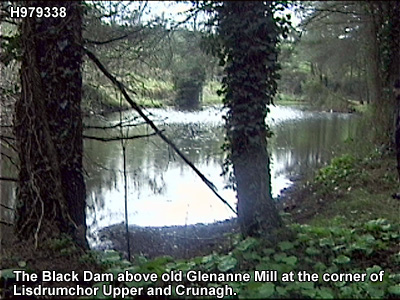
Throughout the eighteenth century and before, linen manufacture was for the most part a domestic activity. Flax was grown and harvested by the family on their own land. The yarn produced was spun by the daughters of the family, prior to being woven by the menfolk.
Linen cloth was produced from the fibres taken from the inside of the flax plant. The flax was grown throughout the springtime and harvested towards the close of the summer. Stalks were pulled from the ground rather than severed by a knife to preserve the length and quality of the fibres.
Following the harvest, the stalks of flax were placed in ponds of still water, known as flax holes, for ten to fourteen days to soften the stems. This process was known as retting. When the flax was sufficiently softened and the outer bark rotted, it was placed in the sun to be dried thoroughly.
The dried flax was firmly beaten using a wooden 'beetle' to separate the skin from the hard, wooden, outer core. Then a process known as scutching was undertaken, by which the supple fibres were pulled through hackle pins (a type of comb) to separate and straighten them. The fibres were spun on a wheel to make them stronger and the yarns measured into lengths of thirty yards. A length of thirty yards was called a 'cut'. Twelve cuts made one hank. Later, this process was completed by machines.
The yarn was brought to the loom where it laid out into warp threads going lengthways and weft threads going across the warp threads. When the weaving was complete, the cloth was once again beetled to leave it shiny and smooth. Using buttermilk and potash, the cloth was boiled to bleach the fabric and left in the sun to whiten. This last process was repeated up to twelve times until the cloth was brilliant-white.
Cloth would remain on bleaching greens for a number of days. Many owners erected small watchtowers to ensure cloth was not stolen during the night. The penalty for stealing linen cloth could be as severe as death or deportation to the colonies.
REFERENCES
Greig, W, General Report on the Gosford Estates in County Armagh with an introduction by FML Thompson and D Tierney (Belfast, 1976)
Hill, P, The Linen Valley (Belfast, 1992)
Marshall, P, "Spence Bryson and Co. Ltd. Linen Weaving Factory, Markethill" , Before I Forget. Journal of the Poyntzpass Historical Society (October 2000, No.8)
In the accompanying recording, John Lund talks about history of the textile industry and its relevance to the area.

Use the audio controller to listen to this talk, given in 2003.
